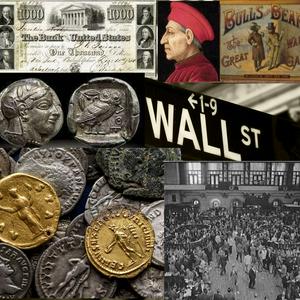47 episodios

Episode 47. How Greek Coins Built Markets, Empires, And Ideas
09/12/2025 | 33 min
Send us a textShips got faster, markets thickened, and stamped silver began doing political work that speeches couldn’t. We follow how Greek city-states turned metal into money and money into power—financing fleets, paying jurors and rowers, and turning owls and gods into portable propaganda. Seigniorage became public revenue, the Agora became a humming marketplace, and social mobility crept in as status shifted from lineage to ledger.We dig into the messy mechanics: clashing weight standards, missing denominations, and the rise of "trapezites" who sat at simple tables and priced trust for a fee. Athens bankrolled prestige by paying Olympic and Isthmian champions, proving that sports funding is ancient soft power. Philosophers pushed back; Aristotle’s fear of endless accumulation echoes today’s debates over fiduciary duty, environmental costs, and the obligations of wealth. Persia minted the gold daric yet watched Greek silver dominate circulation through network effects, while city-states navigated debasement and emergency bronze issues by anchoring coins to taxes and fines.One city refused the current: Sparta, with heavy iron money designed to choke off luxury and bribery. That austere system depended on helots and periokoi, revealing how military readiness and economic insulation fed each other. We also confront the human cost of liquidity—Laurion’s mines powered the money supply through enslaved labor in lethal conditions—alongside a broader view of credit and risk. Barter myths fall away as we map gift economies, ledgers, letters of credit, and the hard truth that when war rises, interest rates and metal hoards rise with it. If this journey through ancient finance and power made you rethink money’s true alloy—trust, law, and force—follow the show, share it with a friend, and leave a quick review to help others find us.Support the showTo support the podcast through Patreon https://www.patreon.com/HistoryOfMoneyBankingTradeVisit us at https://moneybankingtrade.com/ Visit us on YouTube https://www.youtube.com/@MoneyBankingTrade

Episode 46. How Greece Turned Silver Into Power
25/11/2025 | 46 min
Send us a textShips got faster, roads stretched farther, and fear did the rest. We follow Greece from the ashes of the Late Bronze Age collapse to a world where stamped silver didn’t just buy grain and oarsmen—it built fleets, financed wars, and rewired how people thought about law, status, and freedom. Lydia may have minted first, but Ionia made coinage a habit, turning measured metal into everyday money that paid juries, rowers, craftsmen, and mercenaries. As the Agora shifted from public debate to humming marketplace, Athens funded its ambitions through Laurion silver, tribute from subject cities, fines, and liturgies assigned to the wealthy—sidestepping direct taxes while scaling a maritime empire.Mercenaries accelerated the revolution. States needed reliable payrolls, and coins beat IOUs on campaign. Carthage, long tied to ingots, minted in Sicily to pay Greek soldiers, proving how war can force monetary innovation. Seigniorage powered city-states: mints captured the spread between face value and metal cost, turning coinage into civic revenue. Designs mattered. Owls, gods, and later Alexander’s portrait broadcast identity and legitimacy, turning currency into portable propaganda. Silver dominated daily life because it divided cleanly and traveled well; gold stayed in hoards, dowries, and high diplomacy. Where coin circulation rose, money velocity jumped, markets thickened, and specialized labor took root.Beneath the metal ran ideas. The Axial Age brought written laws, standardized measures, and a new respect for reasoned order—perfect companions to standardized money. Numisma, rooted in law, framed coins as instruments of justice as much as exchange. Monetization loosened rigid hierarchies: birth ceded ground to balance sheets, and social mobility edged in without revolution. From owls to armies, from hoards to harbors, this story shows how money’s most durable alloy is trust, law, and the hard calculus of power.If this journey through ancient finance, warfare, and markets sparked new questions, follow and share the show, and leave a review with the one idea you’ll be debating at your next dinner.Support the showTo support the podcast through Patreon https://www.patreon.com/HistoryOfMoneyBankingTradeVisit us at https://moneybankingtrade.com/ Visit us on YouTube https://www.youtube.com/@MoneyBankingTrade

Episode 45. From Sumer To Sparta: How Money, Slavery, And Sea Trade Shaped Greece
11/11/2025 | 55 min
Send us a textForget the tidy tale of Athens inventing everything. We follow the harder, richer path: who counted as a citizen, who powered the mines and fleets, and how alphabets, temples, and trade shaped a world that learned to finance risk before it learned to praise democracy. We trace the consonants of Phoenicia becoming Greek vowels, the spread of colonies from Sicily to Anatolia, and the Etruscan bridge that carried scripts to Rome. Along the way, temples act like strongrooms and lenders, interest rates settle into durable norms, and the agora grows into a marketplace where politics and commerce intertwine.We put Greece beside Sumer and Babylon to see what truly came first: ledgers, codes, and credit in Mesopotamia long predate coinage in the Aegean. Yet scarcity on rocky soils forced Greek ingenuity. Olives and vines fed exports, ships fetched grain from Egypt and the Black Sea, and specialization in pottery and metalwork built surplus. Hoplites rose from independent farms, tying armor to representation. Slavery, however, scaled the economy—across fields, workshops, and the Laurion silver mines that bankrolled triremes—while Solon’s reforms curbed debt bondage to stabilize the citizen body.Risk shaped finance. Maritime loans repaid only on safe arrival, a pragmatic hedge against shipwrecks and piracy that unlocked longer trade routes. Coinage standardized value, courts and contracts slowly enabled impersonal exchange, and private bankers extended credit for grain and commerce. Greece didn’t start ahead; it adapted fast, borrowed smart, and turned sea lanes into power. By the Hellenistic era, coin-rich markets, naval strength, and shared institutions propelled a cultural reach that still frames our world.Join us to reconsider where “Western” really begins, how wealth and labor built states, and why trade—more than myth—powered Greek ascendancy. If this journey challenged your assumptions, follow the show, share it with a friend, and leave a review to help others find it.Support the showTo support the podcast through Patreon https://www.patreon.com/HistoryOfMoneyBankingTradeVisit us at https://moneybankingtrade.com/ Visit us on YouTube https://www.youtube.com/@MoneyBankingTrade

Episode 44. Han’s Tightrope: Markets, Monopolies, and Mandates
28/10/2025 | 33 min
Send us a textWhat if the health of an empire could be read in the trust of its money and the fairness of its institutions? We follow Han China through a gripping arc: from early market freedom and soaring wealth to Emperor Wu’s heavy hand—state monopolies in salt, iron, and liquor, unified coinage, and price-smoothing granaries—and then into the turbulence of debasement, counterfeit coin, and a monetary dark age. Along the way, the Silk Road begins to hum, standards slash fraud, and safer routes let merchants scale. The big question never leaves the stage: how do you let markets innovate while the state secures public goods, strategic industries, and national defense?Power’s center shifts inside the palace as eunuchs move from attendants to advisors to kingmakers. Underage emperors and captured courts turn offices into commodities, selling posts—sometimes on credit—and feeding a patronage machine that guts merit and drains public trust. Land concentrates, smallholders slide into tenancy, and the tax base erodes as elite estates dodge oversight. Then the climate turns cruel. Floods, famines, and plague meet a state that has neglected canals and dikes. The Mandate of Heaven looks broken, and people respond: the Yellow Turban movement rises, is crushed, and leaves the center permanently weakened. Warlords seize the stage, and China fractures into Wei, Shu, and Wu, with economies refocused on agrarian recovery and survival.Still, the Han legacy endures—territorial reach, administrative craft, vibrant trade networks, and lasting achievements in thought and art. The lesson is timeless: prosperity thrives on balance. Money needs credible standards; markets need guardrails; public works need care; and institutions must be shielded from capture. We unpack the policies that worked, the choices that failed, and the signals leaders missed, drawing clear lines to today’s debates on central banking, antitrust, and industrial strategy. If this story challenged your assumptions or echoed our present, share it with a friend, subscribe for more, and leave a review with the policy lever you’d pull first.Support the showTo support the podcast through Patreon https://www.patreon.com/HistoryOfMoneyBankingTradeVisit us at https://moneybankingtrade.com/ Visit us on YouTube https://www.youtube.com/@MoneyBankingTrade

Episode 43. What the Han Dynasty teaches us about monopolies, money, and the uneasy balance between state power and private enterprise
14/10/2025 | 39 min
Send us a textWealth surges, currency crises, and monopolies on life’s essentials—Han China’s economic story feels startlingly current. We dig into the early Western Han’s laissez-faire push that unleashed private enterprise and inequality, then follow Emperor Wu’s decisive swing to state control: salt, iron, and liquor monopolies; centralized minting; and grain “ever-normal” granaries that smoothed prices to prevent famine. The gains were real—stronger coffers, military capacity, and national security—but so were the tradeoffs: stifled innovation, bloated bureaucracy, and simmering public resentment. The debate captured in the 81 BCE “Discourses on Salt and Iron” sounds like today’s hearings on semiconductors, green energy, and AI.The heart of the episode explores money as a trust machine. We unpack how coin debasement, private minting, and Wang Mang’s sprawling 28-currency experiment triggered counterfeiting, hoarding, in-kind payments, and an urban retreat—a monetary dark age. Then the counter-swing: Emperor Guangwu’s political reset and Emperor Ming’s canal, dike, and waterwork rebuilds that rekindled agriculture and trade. We clarify Silk Road myths, tracing complex land-sea networks, the Kushan Empire’s lucrative middleman role, and why precious-metal Roman coins traveled farther than Han bronze. Along the way, we highlight how Chinese ironmaking outpaced Europe by centuries and how paper’s invention transformed administration and paved the way for later financial innovations.By the time Emperor Zhang consolidated the Eastern Han’s second golden age, silk functioned as currency across Central Asia, standards cut fraud, and safer routes unlocked scale for merchants. The throughline is pragmatic balance: markets drive efficiency and invention; the state safeguards stability, public goods, and strategic industries. When trust in money cracks, everything else falters. When control smothers enterprise, growth thins. We connect those lessons to modern antitrust, central banking, and industrial policy, showing why the pendulum keeps swinging—and why smart policy accepts the need to adjust.Enjoyed the journey? Follow, subscribe, and share this episode with someone who loves history that changes how we think about the present. Leave a review to help more curious listeners find the show.Support the showTo support the podcast through Patreon https://www.patreon.com/HistoryOfMoneyBankingTradeVisit us at https://moneybankingtrade.com/ Visit us on YouTube https://www.youtube.com/@MoneyBankingTrade
Más podcasts de Historia
Podcasts a la moda de Historia
Acerca de History of Money, Banking, and Trade
Escucha History of Money, Banking, and Trade, La Historia del Mundo y muchos más podcasts de todo el mundo con la aplicación de radio.net

Descarga la app gratuita: radio.net
- Añadir radios y podcasts a favoritos
- Transmisión por Wi-Fi y Bluetooth
- Carplay & Android Auto compatible
- Muchas otras funciones de la app
Descarga la app gratuita: radio.net
- Añadir radios y podcasts a favoritos
- Transmisión por Wi-Fi y Bluetooth
- Carplay & Android Auto compatible
- Muchas otras funciones de la app


History of Money, Banking, and Trade
Descarga la app,
Escucha.



































